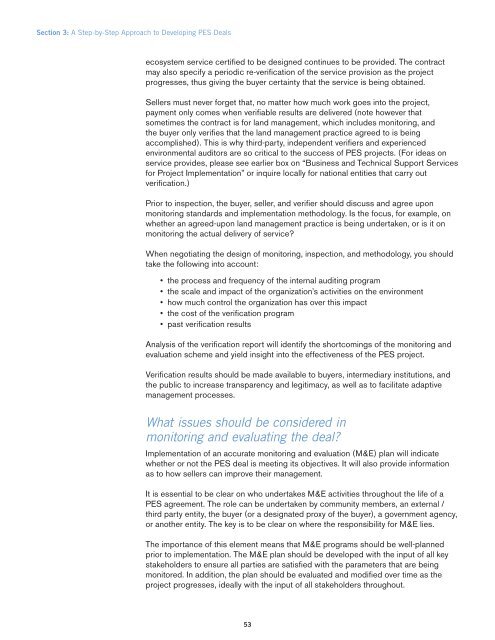Payments for Ecosystem Services: Getting Started. A Primer - UNEP
Payments for Ecosystem Services: Getting Started. A Primer - UNEP
Payments for Ecosystem Services: Getting Started. A Primer - UNEP
You also want an ePaper? Increase the reach of your titles
YUMPU automatically turns print PDFs into web optimized ePapers that Google loves.
Section 3: A Step-by-Step Approach to Developing PES Deals<br />
ecosystem service certifi ed to be designed continues to be provided. The contract<br />
may also specify a periodic re-verifi cation of the service provision as the project<br />
progresses, thus giving the buyer certainty that the service is being obtained.<br />
Sellers must never <strong>for</strong>get that, no matter how much work goes into the project,<br />
payment only comes when verifi able results are delivered (note however that<br />
sometimes the contract is <strong>for</strong> land management, which includes monitoring, and<br />
the buyer only verifi es that the land management practice agreed to is being<br />
accomplished). This is why third-party, independent verifi ers and experienced<br />
environmental auditors are so critical to the success of PES projects. (For ideas on<br />
service provides, please see earlier box on “Business and Technical Support <strong>Services</strong><br />
<strong>for</strong> Project Implementation” or inquire locally <strong>for</strong> national entities that carry out<br />
verifi cation.)<br />
Prior to inspection, the buyer, seller, and verifi er should discuss and agree upon<br />
monitoring standards and implementation methodology. Is the focus, <strong>for</strong> example, on<br />
whether an agreed-upon land management practice is being undertaken, or is it on<br />
monitoring the actual delivery of service?<br />
When negotiating the design of monitoring, inspection, and methodology, you should<br />
take the following into account:<br />
• the process and frequency of the internal auditing program<br />
• the scale and impact of the organization’s activities on the environment<br />
• how much control the organization has over this impact<br />
• the cost of the verifi cation program<br />
• past verifi cation results<br />
Analysis of the verifi cation report will identify the shortcomings of the monitoring and<br />
evaluation scheme and yield insight into the effectiveness of the PES project.<br />
Verifi cation results should be made available to buyers, intermediary institutions, and<br />
the public to increase transparency and legitimacy, as well as to facilitate adaptive<br />
management processes.<br />
What issues should be considered in<br />
monitoring and evaluating the deal?<br />
Implementation of an accurate monitoring and evaluation (M&E) plan will indicate<br />
whether or not the PES deal is meeting its objectives. It will also provide in<strong>for</strong>mation<br />
as to how sellers can improve their management.<br />
It is essential to be clear on who undertakes M&E activities throughout the life of a<br />
PES agreement. The role can be undertaken by community members, an external /<br />
third party entity, the buyer (or a designated proxy of the buyer), a government agency,<br />
or another entity. The key is to be clear on where the responsibility <strong>for</strong> M&E lies.<br />
The importance of this element means that M&E programs should be well-planned<br />
prior to implementation. The M&E plan should be developed with the input of all key<br />
stakeholders to ensure all parties are satisfi ed with the parameters that are being<br />
monitored. In addition, the plan should be evaluated and modifi ed over time as the<br />
project progresses, ideally with the input of all stakeholders throughout.<br />
53
















